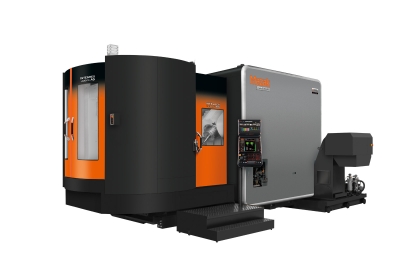
During its recent All Axes LIVE virtual event in February, Mazak showed shops how they can add gear cutting to their part-processing repertoires and eliminate contracting out such work with the company’s INTEGREX i-630V AG HYBRID Multi-Tasking Machine. The machine is built on Mazak’s powerful INTEGREX milling and turning platform and performs gear milling, hobbing and skiving with its SMOOTH Gear Cutting software suite featuring SMOOTH Gear Milling, SMOOTH Gear Hobbing and SMOOTH Gear Skiving.
Equipped with Mazak’s MAZATROL SmoothAi control, SMOOTH Gear Cutting software and additional rotary axis scale feedback, the INTEGREX i-630V AG eliminates the guesswork often associated with gear cutting, particularly in terms of programming and the synchronization of turning/milling spindles at high rpm. The results are a far more refined cutting action and smoother gear teeth surface finishes.
Designed for heavy-duty 5-axis machining and large, highly complex parts, the INTEGREX i-630V AG employs a powerful turning spindle with C-axis control and a rigid milling spindle with B-axis tilt of -30/+120 degrees, both of which are monitored via rotary axis scale feedback. During the All Axes LIVE event demonstration, the machine power skived a 35” diameter gear made from 4140 steel.
For effective gear skiving, the mill spindle and the turning spindle must be synchronized, as any fluctuation in the turning spindle or milling spindle speeds will cause vibration and poor surface quality. If either spindle starts to fluctuate or drift off target speed, the SMOOTH Gear Cutting software automatically adjusts cutting parameters. Without the software, such corrections are very difficult to make in real time, if not impossible.
The software eliminates the need to program the part offline or on a CAM system and ensures synchronization. It provides a graphical user interface on the machine’s control, and users simply fill in various fields with information such as number of gear teeth, pressure angles and the like. With this information, the control will then generate a program that runs in the background as the toolpath is created.
The SmoothAi control runs the SMOOTH Gear Cutting software and delivers powerful digital enhancements that add efficiency and value throughout the machining process with the power of artificial intelligence (AI), machine learning and advanced data management technology. The control incorporates a wide variety of advanced programming functions for complete ease of use and to ensure high-speed, high-accuracy machining performance.
Contact Details
Related Glossary Terms
- computer-aided manufacturing ( CAM)
computer-aided manufacturing ( CAM)
Use of computers to control machining and manufacturing processes.
- gang cutting ( milling)
gang cutting ( milling)
Machining with several cutters mounted on a single arbor, generally for simultaneous cutting.
- milling
milling
Machining operation in which metal or other material is removed by applying power to a rotating cutter. In vertical milling, the cutting tool is mounted vertically on the spindle. In horizontal milling, the cutting tool is mounted horizontally, either directly on the spindle or on an arbor. Horizontal milling is further broken down into conventional milling, where the cutter rotates opposite the direction of feed, or “up” into the workpiece; and climb milling, where the cutter rotates in the direction of feed, or “down” into the workpiece. Milling operations include plane or surface milling, endmilling, facemilling, angle milling, form milling and profiling.
- milling machine ( mill)
milling machine ( mill)
Runs endmills and arbor-mounted milling cutters. Features include a head with a spindle that drives the cutters; a column, knee and table that provide motion in the three Cartesian axes; and a base that supports the components and houses the cutting-fluid pump and reservoir. The work is mounted on the table and fed into the rotating cutter or endmill to accomplish the milling steps; vertical milling machines also feed endmills into the work by means of a spindle-mounted quill. Models range from small manual machines to big bed-type and duplex mills. All take one of three basic forms: vertical, horizontal or convertible horizontal/vertical. Vertical machines may be knee-type (the table is mounted on a knee that can be elevated) or bed-type (the table is securely supported and only moves horizontally). In general, horizontal machines are bigger and more powerful, while vertical machines are lighter but more versatile and easier to set up and operate.
- toolpath( cutter path)
toolpath( cutter path)
2-D or 3-D path generated by program code or a CAM system and followed by tool when machining a part.
- turning
turning
Workpiece is held in a chuck, mounted on a face plate or secured between centers and rotated while a cutting tool, normally a single-point tool, is fed into it along its periphery or across its end or face. Takes the form of straight turning (cutting along the periphery of the workpiece); taper turning (creating a taper); step turning (turning different-size diameters on the same work); chamfering (beveling an edge or shoulder); facing (cutting on an end); turning threads (usually external but can be internal); roughing (high-volume metal removal); and finishing (final light cuts). Performed on lathes, turning centers, chucking machines, automatic screw machines and similar machines.







